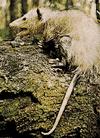- opossum
-
1. a prehensile-tailed marsupial, Didelphis virginiana, of the eastern U.S., the female having an abdominal pouch in which its young are carried: noted for the habit of feigning death when in danger.2. any of various animals of related genera.Cf. possum.[1600-10, Amer.; < Virginia Algonquian (E sp.) opassom, opussum, aposoum (equiv. to Proto-Algonquian *wa·p- white + *-athemw- dog)]
* * *
Highly adaptable and prolific, opossums have changed little in millions of years. The North American species, the stout-bodied common, or Virginia, opossum (Didelphis marsupialis), grows to 40 in. (100 cm) long. It is largely white and has an opposable clawless toe on each hind foot; with its long, hairless, prehensile tail, it resembles a large rat. Up to 25 grublike, 0.07-oz (2-g) newborns compete for the 13 nipples in the pouch, where the survivors spend four or five weeks; they spend the following eight to nine weeks clinging to the mother's back. The common opossum may feign death ("play possum") if surprised. It eats small animals, insects, and fruit, and sometimes domestic poultry and cultivated grain. See also possum. Virginia, or common, opossum (Didelphis virginiana).Robert J. EllisonThe National Audubon Society Collection/Photo Researchers
Virginia, or common, opossum (Didelphis virginiana).Robert J. EllisonThe National Audubon Society Collection/Photo Researchers* * *
any of about 66 species of New World mammals constituting the family Didelphidae of the superorder Marsupialia. For ordinal relatives in American tropics, see rat opossum; for Australasian marsupials called possum, see phalanger.The only species occurring north of Mexico is the common, or Virginia, opossum (Didelphis marsupialis; see photograph—>). It ranges from lower eastern Canada and Puget Sound southward to Argentina; the only other member of that genus, Azara's opossum (D. azarae), is found in South America. The common opossum may grow to 100 cm (40 inches) in length (including the tail) and is about the size of a house cat. Its coarse coat varies from grayish white (in northern regions) to nearly black (in warm regions). It has a pointy white face, beady black eyes, round black ears, and a stout body. The opossum's hairless, scaly, prehensile tail is about half the animal's total length. There are five sharp-clawed toes on each front foot, and the innermost toe on each hind foot is clawless and opposable and can be used for grasping branches. The animal has 50 teeth.The common opossum eats almost anything, including insects, small mammals, eggs, nestlings, fruit, berries, and sometimes cultivated crops. Opossums are almost equally adaptable as to their habitat, but, being largely arboreal, they are absent from treeless, dry areas. Their dens are often found in a hollow tree or under stumps and roots. If surprised on the ground the opossum may feign death; hence the expression “play possum.” The animal's flesh is enjoyed as food locally in the southern United States, where possum hunting is a popular fall and winter sport.The common opossum breeds from mid-winter to late autumn. One litter is produced annually in cooler regions, but as many as three in warmer ones. After only 12 to 16 days of gestation (average 12.5), an opossum may have as many as 25 young; the average number is 10. The young are born blind, naked, and grublike and weigh only 2 g (0.07 ounce). Using their clawed forelimbs, they instinctively struggle toward the mother's fur-lined pouch; those that reach the pouch seek out a nipple—there usually are 13 of them—and achieve a firm oral grip as the nipple swells. Some newborns never succeed in entering the pouch, and others die because there are more young born than there are teats to serve them. After four or five weeks in the pouch the young spend an additional eight or nine weeks clinging to the mother's back. The notion that the opossum gives birth through its nose probably comes from the female's habit of putting her face into the pouch to clean it just before giving birth.The water opossum, or yapok (Chironectes minimus, sometimes panamensis), a carnivorous opposum found from Mexico to Argentina, is the only marsupial adapted to a semiaquatic life: it has webbed hind toes, dense oily fur, and a pouch opening that can be tightened to keep the young dry. It has a head and body length of 30 cm and a 38-centimetre naked tail. The dark upperparts are broadly striped.Woolly opossums include the three species of Caluromys, found from southern Mexico to Brazil, the two species of Glironia, of the northern Andes, andDromiciops australis, of Chile. The gray four-eyed opossum (Philander opossum) and the brown four-eyed, or rat-tailed, opossum (Metachirus nudicaudatus) have a pair of large whitish spots over the eyes. Both are found in Central and South America; they have large heads and long tails, and the latter species is pouchless.The thick-tailed opossum, or little water opossum (Lutreolina crassicaudata), of South America east of the Andes is found chiefly along watercourses but may enter cities. As long as 70 cm, including its 30-centimetre tail, it resembles a weasel and is fiercely carnivorous.The smallest opossums are the shrewlike, small-eyed, rather short-tailed species of Monodelphis, of South America (one, M. melanops, is found in Panama); some are only 15 cm long, the tail included. The most abundant members of the opossum family are the 40 species of Marmosa, sometimes called mouse, or murine, opossums, which are found from northern Mexico to Argentina.* * *
Universalium. 2010.
